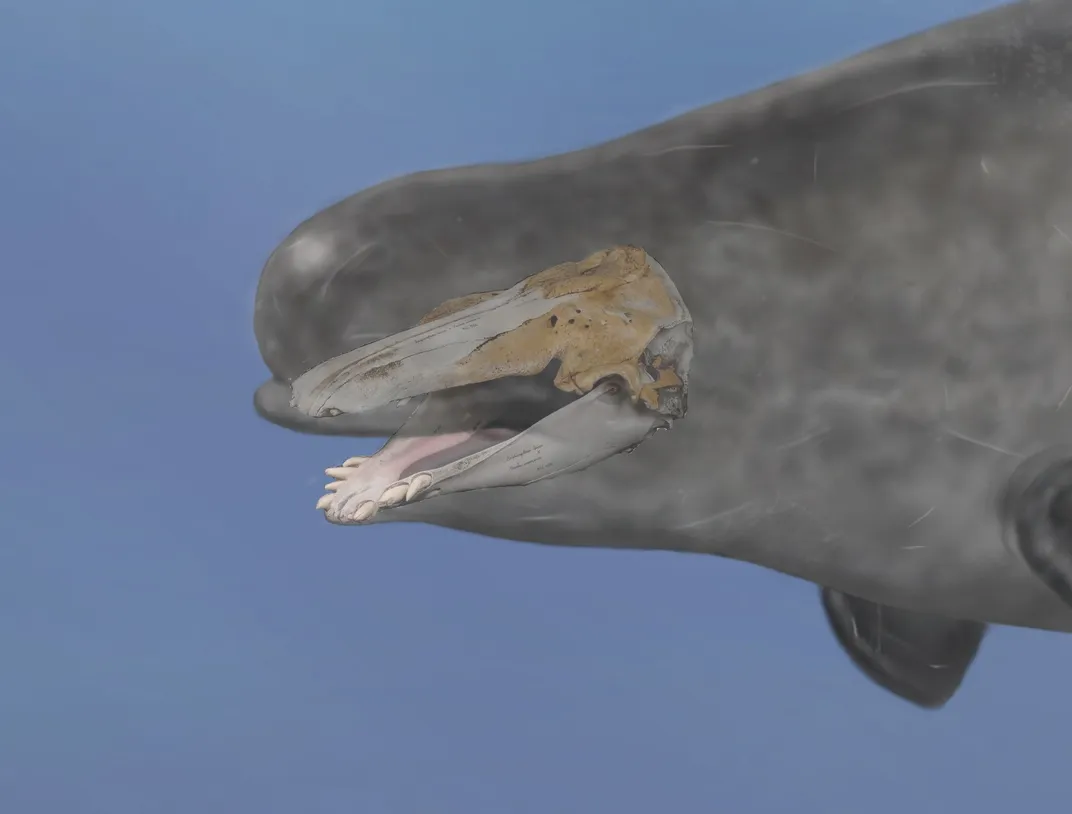This Bizarre Whale Is a Beluga-Narwhal Hybrid
A new study documents what may be the first-known evidence of breeding between the two species
:focal(259x365:260x366)/https://tf-cmsv2-smithsonianmag-media.s3.amazonaws.com/filer/7b/38/7b380a64-6c10-421a-a347-8890c51a7a2e/img_0558.jpg)
In the 1980s, a subsistence hunter caught three unusual-looking whales in Greenland’s Disko Bay. They had flippers shaped like those of belugas, but narwhal-like tails. And their teeth were strange, protruding horizontally from the whales’ mouths. The hunter kept the skull of one of the creatures, hanging it on the roof of his toolshed, and later allowed researchers to take it to the Natural History Museum of Denmark. And now, a team of experts from Denmark and Canada have used DNA analysis to confirm a long-standing theory about the skull: it belonged to a beluga-narwhal hybrid.
The researchers say that this specimen represents, to their knowledge, “the sole evidence of hybridization between the only two toothed whale species endemic to the Arctic,” according to their new study in Scientific Reports. To arrive at this conclusion, the team studied a DNA sample that was extracted from the animal’s odd teeth, and compared it to tissue samples from eight belugas and eight narwhals from Disko Bay.
The genetic material of the mysterious creature was degraded, study author Eline Lorenzen tells Stephanie Pappas of Live Science. But using advanced technologies, the researchers were nevertheless able to determine that the animal was male, and that around 54 percent of its DNA was beluga, the other 46 percent narwhal. This means, according to the study authors, that the animal was a first generation hybrid. By analyzing the specimen’s mitochondrial DNA, which is inherited from the mother, the team also determined that its mother was a narwhal—and, by extension, that the whale got its beluga genes from its dad.
These revelations can help explain some of the animal’s odd quirks. For instance, the hunter who killed the three whales told researchers that their skin was a uniformly grey color; belugas have white skin and narwhals are speckled with brown, black, grey and white. The hybrid’s skull was considerably larger than that of a typical beluga or narwhal, but its teeth seemed to be a bizarre mish-mash of both. Narwhals don’t have any lower teeth, but males have a signature front tooth that spirals impressively out of their lips. Belugas have up to 40 upper and lower teeth aligned in vertical pattern. The hybrid had teeth in both its upper and lower jaws, but its chompers were grooved and some were oriented horizontally, “resembling the tusk and the vestigial tooth of narwhals,” the study authors write.
As part of the new study, the researchers analyzed carbon and nitrogen isotopes extracted from the specimen’s bone collagen, a method often used to determine what animals (and humans) once ate. They found that the whale’s diet was different to that of both its parent species, relying more heavily on prey near the ocean floor.
[I]t is possible that its teeth influenced its foraging strategy,” says Mikkel Skovrind, a PhD student at the Natural History Museum and the study's first author.
Belugas and narwhals diverged from a common ancestor around five million years ago. When the researchers behind the new report looked at the species’ DNA, they found no evidence that the animals had been interbreeding over the past 1.25 million years. This means that the hybrid specimen represents “either a very rare or a new occurrence”—but not an impossible one, according to study author Eline Lorenzen, an ecologist at the University of Copenhagen.
Both narwhal and belugas mate in the spring, as the sea ice is breaking up. The timing makes it difficult for researchers to study the animals’ mating habits, but it is known that narwhals and belugas occur in large numbers in Disko Bay during the mating season. And the fact that the hybrid had a narwhal mother and beluga father makes sense. As Randall Reeves, a whale biologist who was not involved in the new research, tells Tina Hesman Saey of Science News, the tusks of male narwhals might indicate to amorous female belugas that they are not of the same species. But female narwhals and belugas are similar in size and shape, and could easily be mistaken for one another. It is not inconceivable, then, that a male beluga might select a narwhal as its mate.
Whale hybridization may not be a common phenomenon, but it could be happening more than scientists realize. “It would be interesting,” says Skovrind, “to find out if similar hybrid whales have been spotted elsewhere.”
/https://tf-cmsv2-smithsonianmag-media.s3.amazonaws.com/filer/7d/9d/7d9daf83-ca7b-4fcf-949d-370aa1c6cef0/img_0555.jpg)

